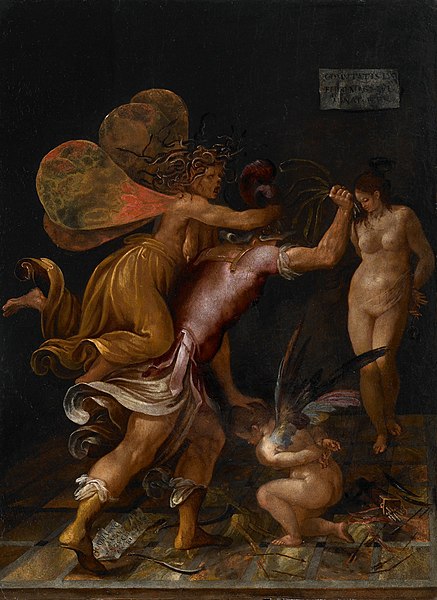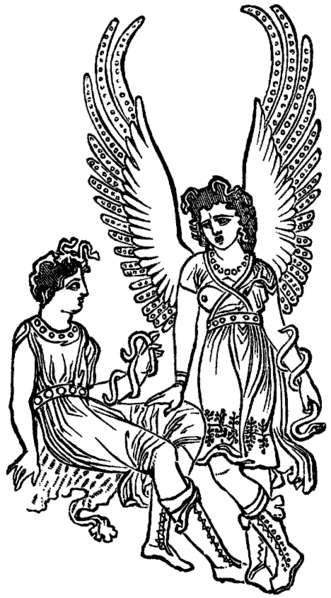the Erinyes—those vengeful deities of Greek mythology, often referred to as the Furies. These goddesses are not to be trifled with, as they embody divine retribution. In the following paragraphs, we’ll delve into their origins, characteristics, and roles, exploring how they’ve been depicted in ancient texts and art.
Erinyes Key Facts
| Parents | Nyx or Uranus and Gaia |
| Partners | None |
| Siblings | Various, depending on the myth |
| Offspring | None |
| Other names | Furies, Dirae |
| Roman name | Furiae |
| The Goddesses of | Vengeance, Retribution |
| Symbols | Whip, torch, snake |
Name and Etymology
The term “Erinyes” is believed to have been derived from the Greek word “Erinys,” which is related to the concept of anger and vengeance. In Roman mythology, they are known as the Furiae or Dirae. These names encapsulate the essence of these goddesses—relentless, unforgiving agents of retribution.
The Erinyes are often individually named as Alecto (“unceasing”), Megaera (“grudging”), and Tisiphone (“avenging murder”). Each name serves as a grim reminder of the specific form of vengeance that each goddess specializes in.
In various myths, they are also referred to by epithets such as “Semnai” (the revered), emphasizing their divine and fearsome nature. These alternative names and titles add layers of complexity to their already enigmatic existence.

Erinyes Origins
The Erinyes are usually considered the daughters of Nyx, the goddess of the night, born from the shadows and the depths of the underworld. However, another version posits them as the offspring of Uranus, The Sky God and Gaia, born from the blood that spilled when Cronus castrated his father.
There’s no tale of a blissful childhood or any special events marking their early years. They were born as adults, fully formed and ready to carry out their divine duties.
As Daemones, or spirits, they serve a specific function in the Greek mythological landscape. They are the personification of the curses uttered by individuals who have been wronged, especially those who are victims of familial betrayal.
Depictions and Characteristics of the Erinyes
When one conjures the image of the Erinyes, it’s not a pleasant sight. These goddesses are often portrayed as winged women, their eyes dripping with blood, and their hands clutching whips or torches. But it’s not just about the shock factor; every element of their appearance serves a purpose. The wings symbolize their omnipresence, their ability to reach anyone, anywhere. The blood in their eyes? A manifestation of the pain and suffering they can inflict.
Their hair is often a tangled mess of serpents, a symbol fraught with meaning. Snakes are creatures that elicit both awe and fear, representing transformation and danger. This duality perfectly encapsulates the essence of the Erinyes. They are also associated with certain plants, like the belladonna, a poisonous nightshade. The deadly nature of this plant serves as a fitting metaphor for the goddesses themselves, who are as alluring as they are dangerous.
The Unyielding Spirit: Personality and Powers
Don’t mistake the Erinyes for malevolent beings; they are not evil incarnate but rather the embodiment of a specific form of justice. They are relentless in their pursuit, unforgiving in their judgments, and exacting in their punishments. They serve as the moral compass of the universe, ensuring that familial betrayals and heinous crimes do not go unpunished.
As for their powers, they are as terrifying as their appearance suggests. They can induce madness, a psychological torment that serves as a form of eternal punishment. They can bring about plagues, affecting not just individuals but entire communities, thereby serving as a collective punishment for societal wrongs. Their most fearsome power, however, lies in their role as punishers of those who commit crimes against their own kin, particularly acts of murder.
Erinyes Roles and Responsibilities
The primary role of the Erinyes is to act as agents of divine retribution. They are the enforcers of moral and social order, particularly within the family unit. They ensure that crimes like murder, particularly patricide and matricide, do not go unpunished.
Their responsibilities extend to the underworld, where they continue to torment the souls of those who have committed heinous acts. They serve as a constant reminder of the consequences of breaking moral and social codes.
Intriguing Myths Featuring the Erinyes
The Erinyes are not just background characters in Greek mythology; they often take center stage, serving as both antagonists and instruments of divine justice. Their presence in myths is a testament to their importance in the Greek understanding of justice, morality, and the cosmic order. Let’s delve into two of the most captivating myths that feature these relentless goddesses.
The Tale of Orestes: A Cycle of Vengeance
In the story of Orestes, the Erinyes serve as the embodiment of the cyclical nature of vengeance. Orestes, son of Agamemnon and Clytemnestra, kills his mother to avenge his father’s murder. This act sets off a chain of events that sees him pursued relentlessly by the Erinyes. They hound him across lands and seas, driving him to the brink of madness. Their pursuit is not out of spite but a manifestation of their divine duty to uphold moral order.
The tale culminates in a trial in Athens, presided over by Athena herself. It is here that the Erinyes undergo a transformation. Athena persuades them to accept the establishment of a legal system to replace the endless cycle of vengeance. They become the Eumenides, the “Kindly Ones,” but their essence remains. They still are the guardians of moral order, only now within the framework of law and justice.
Alcmaeon and the Necklace: The Price of Betrayal
Another myth that prominently features the Erinyes is the tale of Alcmaeon, a figure in Greek mythology who kills his mother, Eriphyle, for having plotted against his father, Amphiaraus. Eriphyle had been bribed with a necklace to send her husband to his death, and Alcmaeon kills her to avenge this betrayal. The act of matricide invokes the wrath of the Erinyes, who chase Alcmaeon relentlessly.
Alcmaeon runs to different cities to escape their wrath and even tries to find a land that didn’t exist when he committed the crime. He believes they can only punish crimes committed in existing territories. However, the Erinyes relentlessly pursue him, drive him to madness, and eventually kill him, fulfilling their hallmark of divine retribution.
In this myth, the Erinyes again serve as agents of a moral order that transcends human laws. They are unyielding in their pursuit, emphasizing the inescapable consequences of violating social and familial norms.
Erinyes in Ancient Greek Religion
The ancient Greek often placed temples dedicated to the Erinyes in secluded areas, away from public view. One temple stood near the Areopagus in Athens, the alleged site of Orestes’ trial.
Although no specific festivals honored the Erinyes, people sometimes included them in rites and ceremonies to avert evil or seek justice. Typical offerings to the Erinyes featured black animals, such as sheep, and libations of honey.
The Erinyes in the Canvas of Time: Artistic Representations
The Erinyes have captivated not just poets and playwrights but also artists, who have sought to capture their complex essence on canvas and in stone. These artistic endeavors span from ancient times to more recent periods, each adding a unique layer to our understanding of these vengeful goddesses. Let’s delve into some of the most compelling artworks that feature the Erinyes.

Ancient Greek Pottery – 5th to 4th Century BCE
In ancient Greek pottery, the Erinyes often appear as fearsome figures who wield their iconic whips and torches.These visual representations, some of the earliest of their kind, serve to emphasize the Erinyes’ role as relentless enforcers of justice and moral order.
“The Consequences of War” by Peter Paul Rubens – 1638
Peter Paul Rubens, the renowned Flemish Baroque painter, included the figure of Alecto, one of the Erinyes, in his masterpiece “The Consequences of War.” In this complex tableau, Alecto is seen dragging Mars, the god of war, towards his destructive purpose, torch held high. Alecto, whose name translates to “unceasing anger,” embodies the relentless, destructive aspects of war. She serves as a symbol of the implacable anger that fuels conflict, a fitting role given her mythological background.
“Orestes Pursued by the Furies” by William-Adolphe Bouguereau – 1862
French academic painter William-Adolphe Bouguereau captures a haunting scene in “Orestes Pursued by the Furies.” The painting focuses on the psychological torment of Orestes, who is hounded by the Erinyes for the act of matricide. The Erinyes loom like dark shadows, emphasizing their role as inescapable agents of divine retribution.
“The Eumenides” Mosaic in Antioch – 2nd Century CE
A striking mosaic discovered in the ancient city of Antioch portrays the Erinyes in their transformed state as the Eumenides. Dating back to the 2nd century CE, this artwork captures them in a more benevolent form, highlighting the societal shift from a focus on vengeance to one of justice and law.
Erinyes in Classical Literature
The Erinyes don’t just exist in myths; they also appear in some of the most important texts of ancient Greece.
Homer’s “Iliad” and “Odyssey” – Around 8th Century BCE
Homer, the epic poet whose works are foundational to the Western literary canon, mentions the Erinyes in both the “Iliad” and the “Odyssey.” In these texts, they are invoked as agents of justice, often called upon to witness oaths and punish liars.
Quote from the “Odyssey”:
“May the Erinyes, who punish men, destroy you both before you are tried and found wanting.”
Aeschylus’ “Oresteia” – 5th Century BCE
Aeschylus, one of the great tragedians of ancient Greece, gives the Erinyes a significant role in his trilogy, the “Oresteia.” In the final play, “The Eumenides,” they transform from vengeful spirits into benevolent deities, symbolizing the transition from a society based on vendetta to one based on law and justice.
Quote from “The Eumenides”:
“Blood of vengeance, stay, stay in your dark chasm. Do not destroy this man. He is purified.”
Sophocles’ “Electra” – 5th Century BCE
In his play “Electra,” eminent Greek playwright Sophocles also invokes the Erinyes to avenge the death of Agamemnon. Their role here is similar to that in the “Oresteia,” serving as instruments of divine justice.
Euripides’ “Hippolytus” – 428 BCE
In Euripides’ tragedy “Hippolytus,” Theseus, The Founding Hero Of Athens invokes the Erinyes to curse his son, Hippolytus. In this context, the Erinyes act as executors of curses, emphasizing their role as enforcers of moral and social norms.
Frequently Asked Questions
The Erinyes symbolize divine retribution and justice, particularly within the family unit.
No, they are not evil; they are enforcers of moral and social order.
They have the power to drive people mad, bring plagues, and summon the spirits of the dead.
They are either the daughters of Nyx or born from Uranus and Gaia.
Featured Image Credit: Henry Fuseli, Public domain, via Wikimedia Commons
